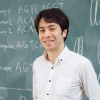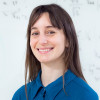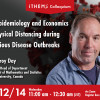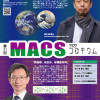151 events in 2022
-
Seminar

How to infer evolutionary history
December 22 (Thu) 16:00 - 17:00, 2022
Jeffrey Fawcett (Senior Research Scientist, RIKEN Interdisciplinary Theoretical and Mathematical Sciences Program (iTHEMS))
One main goal of evolutionary studies is to infer the evolutionary that explains the current diversity. We want to infer the ancestral state and what kind of changes occurred from the previous ancestral state to the current state. In other words, we want to infer the phylogenetic relationship that explains the branching pattern that leads to the current diversity and infer the state at each node and the changes that occurred in each branch of the phylogeny. In this talk, I will introduce some basic concepts that are used in evolutionary biology to tackle these questions, especially how molecular data, i.e., DNA and protein sequence data, can be utilized. This talk will be introductory and aimed at non-experts including non-biologists.
Venue: via Zoom
Event Official Language: English
-
Seminar
Modelling Optical Signals from Magnetar-Driven Supernovae
December 20 (Tue) 14:00 - 15:00, 2022
Conor Omand (Postdoctoral Researcher, Department of Astronomy, Stockholm University, Sweden)
Many energetic supernovae are thought to be powered by the rotational energy of a highly-magnetized, rapidly-rotating neutron star. The emission from the associated luminous pulsar wind nebula (PWN) can affect the system in different ways, including accelerating the ejecta, ionizing the ejecta, and breaking the spherical symmetry through hydrodynamic instabilities or large scale asymmetries. Modeling the observables from these processes; the light curves, spectrum, and polarization; is essential from understanding the nature of the central engine. I will present the results of a radiative transfer study looking at the effects of a PWN on the supernova nebular spectrum, and the preliminary results from a more physically motivated light curve model for parameter inference, and a study examining the polarization that arises due to hydrodynamic instabilities in the ejecta of engine-driven supernovae.
Venue: Common Room #246-248 / via Zoom
Event Official Language: English
-
Seminar

The ANDES Deep Underground Laboratory in South America: status and prospects
December 19 (Mon) 12:30 - 13:30, 2022
Maria Manuela Saez (Postdoctoral Researcher, RIKEN Interdisciplinary Theoretical and Mathematical Sciences Program (iTHEMS))
The construction of the Agua Negra tunnels that will link Argentina and Chile under the Andes mountains opens the possibility of building a deep underground laboratory in the Southern Hemisphere. Dark Matter particles can be detected directly via their elastic scattering with nuclei, and next-generation experiments can eventually find physical evidence about dark matter candidates. I will show you our predictions for the expected direct dark matter signal and the ANDES site laboratory, whose location in the Southern Hemisphere should play a significant role in understanding dark matter modulation signals. Additionally, since planned next-generation large-scale direct detection experiments will measure the coherent elastic scattering of neutrinos on protons and nuclei, we have calculated the SN neutrino signal expected for the location. Finally, to study the background, we have calculated the contributions to the neutrino floor by considering the reactor’s neutrinos and geoneutrinos at the laboratory site. We hope these studies might contribute to dark matter detection strategies that maximize the future ANDES laboratory detection capabilities.
Venue: via Zoom
Event Official Language: English
-
Seminar
CM minimization and special K-stability
December 16 (Fri) 14:00 - 16:30, 2022
Masafumi Hattori (Ph.D. Student, Department of Mathematics, Graduate School of Science, Kyoto University)
Odaka proposed a conjecture predicting that the degrees of CM line bundles for families with fixed general fibers are strictly minimized if the special fibers are K-stable. This conjecture is called CM minimization and a quantitative strengthening of the conjecture of separatedness of moduli spaces of K-stable varieties (K-moduli). This conjecture was already shown for K-ample (Wang-Xu), Calabi-Yau (Odaka) and Fano varieties (Blum-Xu). In this talk, we introduce a new class, special K-stable varieties, and settle CM minimization for them, which is a generalization of the above results. In addition, we would like to explain an important application of this, construction of moduli spaces of uniformly adiabatically K-stable klt trivial fibrations over curves as a separated Deligne-Mumford stack in a joint work with Kenta Hashizume to appear. This is based on arXiv:2211.03108.
Venue: via Zoom
Event Official Language: English
-
Seminar
Geometric decomposition of entropy production in stochastic and chemical systems
December 16 (Fri) 13:30 - 15:00, 2022
Kohei Yoshimura (Ph.D. Student, Department of Physics, Graduate School of Science, The University of Tokyo)
Entropy production is central to understanding nonequilibrium phenomena. It is known that decomposing entropy production enables us to separately treat distinct two aspects of dynamics, nonstationarity and breaking of detailed balance. In this seminar, I talk about our recent progress on geometric decomposition of entropy production in discrete stochastic systems and deterministic chemical systems. For the audience who may not be familiar with nonequilibrium thermodynamics and linear algebraic graph theory, which the latter enables us to treat the two kinds of systems at once, I would like to start with a very basic introduction. Then I explain why and how we decompose entropy production. Specifically, I mainly focus on the "Onsager-projective decomposition" we study in arXiv:2205.15227 rather than the information geometric decomposition provided in the following paper arXiv:2206.14599. Further, several physical consequences will be discussed, including generalization of Schnakenberg's decomposition stemming from cycles in a steady system, and its relation to gradient flow expressions of a master equation and a rate equation.
Venue: via Zoom
Event Official Language: English
-
Seminar
Chemophoresis Engine: Theory of ATPase-driven Cargo Transport
December 15 (Thu) 16:00 - 17:00, 2022
Takeshi Sugawara (Project Researcher, Universal Biology Institute, The University of Tokyo)
The formation of macromolecule patterns depending on chemical concentration under non-equilibrium conditions, first observed during morphogenesis, has recently been observed at the intracellular level, and its relevance as intracellular morphogen has been demonstrated in the case of bacterial cell division. These studies have discussed how cargos maintain positional information provided by chemical gradients. However, how cargo transports are directly mediated by chemical gradients remains unknown. Based on the previously proposed mechanism of chemotaxis-like behavior of cargos (referred to as chemophoresis), we introduce the chemophoresis engine as a physicochemical mechanism of cargo motion, which transforms chemical free energy to directed motion through the catalytic ATP hydrolysis [1]. We propose its possible role as a universal principle of hydrolysis-driven intracellular transport.
Venue: via Zoom
Event Official Language: English
-
Seminar

Lattice gauge theory in curved spacetimes
December 15 (Thu) 14:00 - 15:30, 2022
Arata Yamamoto (Assistant Professor, Department of Physics, Graduate School of Science, The University of Tokyo)
Lattice gauge theory is a powerful computational approach in quantum field theory. It is also utilizable for investigating quantum phenomena in curved spacetimes, such as rotating frame, torsion, and gravitational backgrounds. In this talk, I would like to overview the formulation and results of lattice simulations in curved spacetimes.
Venue: Common Room #246-248 (Main Venue) / via Zoom
Event Official Language: English
-
Colloquium

The Epidemiology and Economics of Physical Distancing during Infectious Disease Outbreaks
December 14 (Wed) 11:00 - 12:30, 2022
Troy Day (Professor, Head of Department, Department of Mathematics and Statistics, Queen's University, Canada)
People's incentives during an infectious disease outbreak influence their behaviour, and this behaviour can impact how the outbreak unfolds. Early on during an outbreak, people are at little personal risk of infection and hence may be unwilling to change their lifestyle to slow the spread of disease. As the number of cases grows, however, people may then voluntarily take extreme measures to limit their exposure. Political leaders also respond to the welfare and changing desires of their constituents, through public health policies that themselves shape the course of the epidemic and its ultimate health and economic repercussions. In this talk I will use ideas from the study of differential games to model how individuals’ and politicians’ incentives change during an outbreak, and the epidemiological and economic consequences that ensue when these incentives are acted upon. Motivated by the COVID-19 pandemic, I focus on physical distancing behaviour and the imposition of stay-at-home orders by politicians. I show that there is a fundamental difference in the political, economic, and health consequences of an infectious disease outbreak depending on the degree of asymptomatic transmission. If transmission occurs primarily by asymptomatic carriers, then politicians will be incentivized to impose stay-at-home orders earlier and for longer than individuals would like. Despite such orders being unpopular, however, they ultimately benefit all individuals. On the other hand, if the disease is transmitted primarily by symptomatic infections, then individuals are incentivized to stay at home earlier and for longer than politicians would like. In this case, politicians will be incentivized to impose back-to-work orders that, despite being unpopular, will again ultimately be to the benefit of all individuals. This is joint work with David McAdams, Fuqua School of Business and Economics Department, Duke University.
Venue: via Zoom
Event Official Language: English
-
Seminar
Chiral effects on lepton transport in core-collapse supernovae
December 13 (Tue) 13:30 - 15:00, 2022
Di-Lun Yang (Assistant Research Fellow, Institute of Physics, Academia Sinica, Taiwan)
Dynamics of leptons such as electrons and neutrinos play an important role in the evolution of core-collapse supernovae (CCSN). Nevertheless, chirality as one of fundamental microscopic properties that could affect lepton transport, through e.g. weak interaction, has been mostly overlooked. In this talk, I will discuss how chiral effects such as the renowned chiral magnetic effect (CME), generating an electric charge current along magnetic fields with chirality imbalance, could result in the unstable modes of magnetic fields and inverse cascade, which potentially influence the matter evolution in CCSN and pulsar kicks. I will also show how an effective CME could be realized via the backreaction from neutrino radiation even in the absence of an axial charge characterizing an unequal number of right- and left-handed electrons.
Venue: Hybrid Format (Common Room 246-248 and Zoom)
Event Official Language: English
-
Seminar
Quantum kinetics of neutrinos in high-energy astrophysical phenomena
December 9 (Fri) 14:00 - 15:00, 2022
Hiroki Nagakura (Specially Appointed Assistant Professor (NAOJ Fellow), Division of Science, NAOJ)
Neutrinos are the most mysterious and elusive particles in the standard model of particle physics. They play important roles in core-collapse supernovae and binary neutron star mergers as driving mass-ejection, synthesizing heavy elements including r-process nuclei, and neutrino signals from these sources. This exhibits the importance of accurate modeling of neutrino radiation field in these phenomena, which will be used to connect neutrino physics to multi-messenger astronomy. It has recently been suggested that neutrino-flavor conversion (or neutrino-oscillation) can ubiquitously occur in these astrophysical environments, exhibiting the requirement of quantum kinetic treatments in the modeling of neutrino transport. In this seminar, I will give an overview of the quantum kinetics neutrino transport and then introduce its recent progress, paying a special attention to the connection to astrophysics. I will also present the latest results of our numerical simulations of collective neutrino oscillations, which can be properly accounted for only by quantum kinetic framework.
Venue: via Zoom
Event Official Language: English
-
Seminar

Carrollian hydrodynamics near the black hole horizon
December 8 (Thu) 16:00 - 17:30, 2022
Puttarak Jai-akson (Postdoctoral Researcher, RIKEN Interdisciplinary Theoretical and Mathematical Sciences Program (iTHEMS))
The membrane paradigm provides a fascinating bridge between gravitational dynamics near black hole horizons (null boundaries) and fluid dynamics. One question naturally follows: what type of fluids and hydrodynamics emerged at the horizon? Contrary to the longstanding belief, it turns out that the horizon fluid is Carrollian, rather than the Galilean (Navier-Stokes) fluid. The Carroll geometries and Carrollian physics, arising originally when the speed of light goes to zero (c to 0 limit), have recently gained increasing attention in the fields of black hole physics and flat holography. In this presentation, I will talk about the Carrollian limit and the resulting Carroll geometries and this unusual kind of hydrodynamics, the Carrollian hydrodynamics. I will then present the geometrical construction of the membrane (also known as the stretched horizon) in a way that a Carroll geometry manifest, therefore allowing us to spell out precisely the dictionary between gravitational degrees of freedom on the membrane and the Carrollian fluid quantities. I will also show that the Einstein’s equations projected onto the horizon are the Carrollian hydrodynamic conservation laws. Lastly, I will discuss the covariant phase space of the horizon, symmetries, and conservation laws. The talk is based on arXiv:2209.03328 and arXiv:2211.06415.
Venue: Hybrid Format (Common Room 246-248 and Zoom)
Event Official Language: English
-
Seminar
Cosmic Birefringence: how our universe violates left-right symmetry
December 6 (Tue) 13:30 - 15:00, 2022
Tomohiro Fujita (Assistant Professor, Waseda Institute for Advanced Study, Waseda University)
Our universe is lefty: recent observations imply that the polarization plane of light that has traveled through cosmic space for 13.8 billion years rotates about 0.3 degrees to the left. A similar phenomenon is known to occur in materials such as crystals, and is called birefringence. But why does birefringence occur even in the outer space, which is supposed to be a vacuum? Dark energy, the unknown energy that fills the universe, may be responsible for it. In this seminar, I will review observations and theories of cosmic birefringence and discuss future prospects.
Venue: Hybrid Format (Common Room 246-248 and Zoom)
Event Official Language: English
-
Seminar

Efficient encoding of the Schrodinger equation on quantum computers
December 5 (Mon) 14:00 - 15:30, 2022
Ermal Rrapaj (Postdoctoral Researcher, RIKEN Interdisciplinary Theoretical and Mathematical Sciences Program (iTHEMS))
The continuous space Schrödinger equation is reformulated in terms of spin Hamiltonians. For the kinetic energy operator, the critical concept facilitating the reduction in model complexity is the idea of position encoding. A binary encoding of position produces a spin-1/2 Heisenberg-like model and yields exponential improvement in space complexity when compared to classical computing. Encoding with a binary reflected Gray code (BRGC), and a Hamming distance 2 Gray code (H2GC) reduces the model complexity down to the XZ and transverse Ising model respectively. Any real potential is mapped to a series of k-local Ising models through the fast Walsh transform. As a first step, the encoded Hamiltonian is simulated for quantum adiabatic evolution. As a second step, the time evolution is discretized, resulting in a quantum circuit with a gate cost that is better than the Quantum Fourier transform. Finally, a simple application on an ion-based quantum computer is provided as proof of concept.
Venue: Common Room #246-248 (Main Venue) / via Zoom
Event Official Language: English
-
Seminar
Tricritical phenomena in holographic chiral transitions
November 29 (Tue) 13:30 - 15:00, 2022
Masataka Matsumoto (Postdoctoral Researcher, Department of Physics, Shanghai University, China)
Tricritical point (TCP) is the end-point of a line of three-phase coexistence (a triple line) at which three coexisting phases simultaneously become identical. A TCP can be observed in various systems, for example, the QCD phase diagram with the chiral limit and a metamagnet such as a FeCl2 crystal. In the AdS/CFT correspondence, a TCP associated with a chiral phase transition has been found in the D3/D7 model [1]. In this talk, I will discuss the recent study [2] of critical phenomena at a tricritical point which emerges in the D3/D7 model in the presence of a finite baryon number density and an external magnetic field. We found all the critical exponents defined in this paper take the mean-field values. I will also compare the results with our previous works about the critical phenomena at the TCP that emerges in the steady state [3,4].
Venue: Hybrid Format (Common Room 246-248 and Zoom)
Event Official Language: English
-
Seminar
Community assembly and species coexistence in the heterogeneous world
November 28 (Mon) 16:00 - 17:00, 2022
Naoto Shinohara (Assistant Professor, Graduate School of Life Sciences, Tohoku University)
How ecological communities are assembled and maintained is a fundamental question in community ecology. To tackle this challenge in the heterogeneous world, we need to understand how community assembly patterns change with environmental gradients and how species coexist in temporally fluctuating environments. In the first of my talk, I introduce our study on how plant community assembly patterns change along with the largest global environmental gradient, the latitudinal gradient. Then, I will present how the seasonal variability of environments contributes to the coexistence of phytoplankton species in a lake. These results altogether uncover how spatiotemporal heterogeneity of environments forms ecological communities in nature.
Venue: Hybrid Format (Common Room 246-248 and Zoom)
Event Official Language: English
-
Seminar
Tropical methods in Enumerative Geometry and Mirror Symmetry
November 25 (Fri) 14:00 - 16:00, 2022
Michel Van Garrel (Assistant Professor, School of Mathematics, University of Birmingham, UK)
Abstract for the 1st hour: Enumerative Geometry has been a feature of mathematics from its beginnings, just think about the number of lines in the plane passing through 2 points. I will take you on a history of the subject and its relationship to other areas of mathematics and physics. Abstract for the 2nd hour: Many problems in mathematics are solved by taking a limit and solving the limiting problem. Tropical geometry is a key technique that allows us to do this systematically. I will talk about the following problem. Take the complex projective plane S and an elliptic curve E in S. Count algebraic maps from the affine line into the complement S \ E. This counting problem is solved via tropical geometry as I will describe in this talk.
Venue: Hybrid Format (Common Room 246-248 and Zoom)
Event Official Language: English
-
Seminar

RNA-Puzzles - the evaluation and automation of RNA 3D structure
November 24 (Thu) 16:00 - 17:00, 2022
Zhichao (Chichau) Miao (Principal Investigator, Guangzhou Laboratory, China / Guangzhou Medical University, China)
RNA-Puzzles is a collective endeavour dedicated to the advancement and improvement of RNA 3D structure prediction. With agreement from crystallographers, the RNA structures are predicted by various groups before the publication of the crystal structures. Systematic protocols for comparing models and crystal structures are described and analyzed. In RNA-Puzzles, we discuss a) the capabilities and limitations of current methods of 3D RNA structure based on sequences; b) the progress in RNA structure prediction; c) the possible bottlenecks that hold back the field; d) the comparison between the automated web server and human experts; e) the prediction rules, such as coaxial stacking; f) the prediction of structural details and ligand binding; g) the development of novel prediction methods; and h) the potential improvements to be made. Till now, 37 RNAs with crystal structures have been predicted, while many of them have achieved high accuracy in comparison with the crystal structures. We have summarized part of our results in three papers and two community-wide meetings. With the results in RNA-Puzzles, we illustrate that the current bottlenecks in the field may lie in the prediction of non-Watson-Crick interactions and the reconstruction of the global topology. Correct coaxial stacking and tertiary contacts are key for the prediction of RNA architecture, while ligand binding modes can only be predicted with low resolution. For the model evaluation, we present RNA-Puzzles toolkit, a computational resource including (i) decoy sets generated by different RNA 3D structure prediction methods, (ii) 3D structure normalization, analysis, manipulation, visualization tools and (iii) 3D structure comparison metric tools. With the increasing number of RNA structures being solved as well as the high-throughput biochemical experiments, RNA 3D structure prediction is becoming routine and accurate. Structure modelling may effectively help in understanding the viral RNA structures, including the SARS-CoV-2.
Venue: via Zoom
Event Official Language: English
-
Seminar
Energy partition in Weibel-mediated shock waves: from Supernova Remnants to Gamma-Ray Bursts
November 24 (Thu) 14:00 - 15:00, 2022
Arno Vanthieghem (Princeton-NINS Postdoctoral Research Fellow, Department of Astrophysical Sciences, Princeton University, USA)
Gamma-ray bursts and supernovae provide ideal environments for efficient energy channeling between different plasma species through collective processes such as collisionless shock waves. Extensively studied in astrophysical and laboratory environments, observations and kinetic simulations indicate strong electron heating in the precursor of collisionless shock waves propagating in unmagnetized electron-ion plasmas. We outline a theoretical model accounting for electron heating via a Joule-like process through the interplay between pitch-angle scattering in the microturbulence and the coherent electrostatic field induced by the difference in inertia between species. Using analytical kinetic estimates, semi-analytical Monte Carlo methods, and ab-initio Particle-In-Cell simulations, we demonstrate the validity of this model in the relativistic regime relevant to the afterglow emission of gamma-ray burst and extend it to characterize the electron-to-ion-temperature ratio in the downstream of nonrelativistic high-Mach numbers shock waves relevant for supernova remnants and laboratory experiments.
Venue: via Zoom
Event Official Language: English
-
Seminar
Tetra and pentaquarks with multi-flavor contents
November 22 (Tue) 13:30 - 15:00, 2022
Atsushi Hosaka (Professor, Research Center for Nuclear Physics, Osaka University)
Recent hadron experiments keep providing evidences of exotic hadrons with multi-quark components. These multiquarks are self-arranged into various configurations such as diquarks, hadronic molecules and so on. In this seminar, we discuss possible structures of tetra and pentaquarks with multi-flavor contents including recently observed T_cc, Pc and P_cs. Based on our recent studies in the quark model and hadron models, we discuss where and how different quark structures emerge.
Venue: Hybrid Format (Common Room 246-248 and Zoom)
Event Official Language: English
-
Colloquium

The 21st MACS Colloquium
November 18 (Fri) 15:00 - 18:00, 2022
Yutaka Yoshikawa (Professor, Division of Earth and Planetary Sciences, Graduate School of Science, Kyoto University)
Zhaomin Hou (Chief Scientist, Organometallic Chemistry Laboratory, RIKEN Cluster for Pioneering Research (CPR) / Group Director, Advanced Catalysis Research Group, RIKEN Center for Sustainable Resource Science (CSRS))15:00-16:00 Talk by Dr. Yutaka Yoshikawa (Division of Earth and Planetary Sciences, Kyoto University) "The Earth Climate and Ocean Surface Waves" 16:15-17:15 Talk by Dr. Zhaomin Hou (Organometallic Chemistry Laboratory, RIKEN Cluster for Pioneering Research / Advanced Catalysis Research Group, RIKEN Center for Sustainable Resource Science) "New Catalysts, New Reactions and New Functional Materials" 17:15-18:00 Discussion
Venue: via Zoom
Event Official Language: Japanese
151 events in 2022
Events
Categories
series
- iTHEMS Colloquium
- MACS Colloquium
- iTHEMS Seminar
- iTHEMS Math Seminar
- DMWG Seminar
- iTHEMS Biology Seminar
- iTHEMS Theoretical Physics Seminar
- Information Theory Seminar
- Quantum Matter Seminar
- ABBL-iTHEMS Joint Astro Seminar
- Math-Phys Seminar
- Quantum Gravity Gatherings
- RIKEN Quantum Seminar
- Quantum Computation SG Seminar
- Asymptotics in Astrophysics Seminar
- NEW WG Seminar
- GW-EOS WG Seminar
- DEEP-IN Seminar
- ComSHeL Seminar
- Lab-Theory Standing Talks
- Math & Computer Seminar
- GWX-EOS Seminar
- Quantum Foundation Seminar
- Data Assimilation and Machine Learning
- Cosmology Group Seminar
- Social Behavior Seminar
- QFT-core Seminar
- STAMP Seminar
- QuCoIn Seminar
- Number Theory Seminar
- Berkeley-iTHEMS Seminar
- iTHEMS-RNC Meson Science Lab. Joint Seminar
- Academic-Industrial Innovation Lecture
- RIKEN Quantum Lecture
- Theory of Operator Algebras
- iTHEMS Intensive Course-Evolution of Cooperation
- Introduction to Public-Key Cryptography
- Knot Theory
- iTHES Theoretical Science Colloquium
- SUURI-COOL Seminar
- iTHES Seminar
